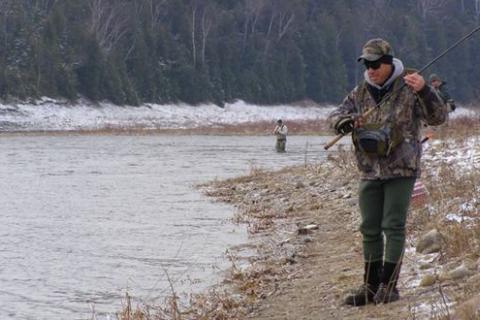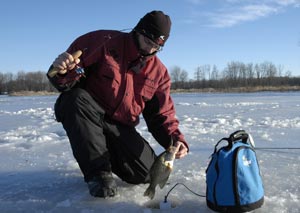
 |
| Dressing in layers will help you regulate your temperature and stay dry. |
With winter's cold weather and snow tightly gripping much of the country, many individuals surrender their enthusiasm for the outdoors, adopting a mock-hibernation approach until warmer temperatures return in the spring. Yet with a little planning and the right cold weather gear, the cold shouldn't keep you from enjoying the outdoors. Whether you're wishing you could be more active in the winter or interested in cold weather activity tips, this guide will share some insights to safely stay active outdoors when temperatures drop below freezing.
Monitor the Weather
Being prepared is critical when dealing with cold weather. To make sure you're ready for the elements, check the local weather and the forecasts for your destination. Monitor weather warnings and make sure you dress accordingly. You'll also empower yourself if you learn how to read satellite and radar imagery (available on most internet weather websites), and not solely rely on the short and long term forecasts. Once you're in the field, keep up to date on weather by whatever means you've got. Local media is one way. If in remote locations, tune into weather radio stations.
Also an option is using GPS units to monitor barometric pressure for a general forecast (falling pressure often brings cloudy weather and possibly precipitation, while rising pressure often means blue skies and clearing weather). Some high-end GPS units will even receive real-time weather information. Monitoring the weather will ensure you have what you need to stay warm when outdoors, but it will also help you make informed decisions on when to cut a trip short or cancel one due to bad conditions.
About Wind-Chill
Wind-chill is the cooling the body encounters when the cold temperature is combined with wind. Wind takes away the layer of heat surrounding and insulating your body. The colder the temperature and faster the wind, the quicker heat will be pushed away from the body. Lack of clothing protection will expedite the effects of wind-chill. The body loses heat and energy as it tries to warm the layer of air, which is getting pushed away by wind. Over time this can result in the skin's temperature falling, which can lead to frostbite and potentially hypothermia in extreme conditions. Dressing properly and keeping skin protected and unexposed are critical to protecting yourself in cold weather.
Regulate Your Temperature with a Base Layering System
Dressing in base layers will help you regulate your temperature and stay dry. In the layering system, the first layer wicks away moisture to prevent the body from becoming chilled by moist clothing. Thermal underwear is an example of the first layer. The middle layer(s) provides insulation, such as fleece shirts and pants. If active, you can remove one of these layers, or add a layer if inactive. The final layer protects from wind as well as rain and snow; it protects the other two layers as well as your body from the environment. Jackets and pants made of Gore-Tex make for an ideal outer shell/third layer.
Whether you're going for a two-hour snowshoe hike or a multi-day ice-fishing trip, always pack various insulating layers and bring spare clothing to be ready for changing weather conditions. Spares come in handy to replace sweaty clothes before heading out in the cold, such as changing socks after a car ride to the entry point of your outdoor excursion. Another example is changing hats or mittens after they've become too wet to provide proper insulation. For more information on how to layer clothing, see the Buying Guide, Learning to Layer Clothing.
Hydration & Nutrition Will Help Keep You Warm
 |
| Staying hydrated is important to keeping warm in cold environments. Include a water bottle as outdoor gear. |
Many of us only think of bringing extra water in hot conditions, but staying hydrated is important to keeping warm in cold environments. If you're active you'll perspire in cold temperatures and will need to replenish fluids lost from your body. Hot drinks can really pay off to stay hydrated as well as warm you up. A high-end thermos will keep liquids hot for hours even in cold temperatures.
In cold weather your body will also be using energy to stay warm, and you'll need to keep the internal fire stoked with enough calories. Bring meals and snacks that require minimal preparation. If you've got a stove; hot cereals, pasta, or hearty stews are great meals on full or multi-day outings.
You'll also want to carry a lot of snacks. Snacks let you top-up your fuel resources throughout the day. Grazing, or frequent snacking, is good practice to stay keep your energy level high. A trail mix consisting of mixed nuts, dried fruit, seeds, and raisins is a good bet when it comes to snacks. Granola bars and real fruit or the dried bars (or leather) are other snack-worthy options.
It's a wise habit to always take some food with you. You might not always need it, but if you even get stranded and need to spend a night outdoors, having food on hand will pay big dividends in keeping your body properly fueled and able to keep warm. Without enough energy to stay active and heat your body, you'll find yourself tiring easily outdoors, and in extreme weather, this can contribute to the body's core temperature dropping.
Hypothermia Fast Facts
Hypothermia occurs when the body's temperature drops below normal, limiting its ability to perform its basic functions. Exposure to extreme cold weather or prolonged exposure to cold temperatures when not properly dressed can lead to hypothermia. Hypothermia occurs on a continuum, with extreme conditions being life-threatening. Uncontrollable shivering, reduced motor skills, and slurred speech are some signs of hypothermia in the middle of the continuum. If any of these conditions are demonstrated by someone in your outdoor group, get them to shelter and warm them with non-alcoholic, hot drinks, blankets, dry clothes, and put them near a source of heat like a fire or a woodstove. If conditions worsen, such as inability to stand-up or are incoherent; get them to medical attention immediately as they may be suffering from severe hypothermia.
Gear to Keep You Warm & Comfortable
The outdoor industry is full of useful gadgets to keep us warm and comfortable, when it's cold outside. Here are some additions for your outdoor arsenal:
Sunglasses: Too often forgotten when outdoors in the winter which is a big mistake. Glare from snow and ice as well as stinging, cold wind can leave you squinting all day and reduce your visibility. Sunglasses will protect eyes from UV rays and wind.
Fleece: This is an amazing material, providing excellent insulation. Fleece clothing that's combined with a wind resistant treatment to offer protection from wind chill is even better than just fleece.
Flannel-Lined Pants: are another personal favorite -- when out for short walks along local trails, Flannel-lined pants offer great protection and comfort from the cold. Team them up with thermal underwear for even more insulation.
Gaiters: These an extremely simple, but an amazing piece of outdoor gear. Designed to keep snow and slush from getting into your boots, gaiters serve snowshoe and cross-country enthusiasts as well as hikers.
Heated Socks: These might seem like a gimmick, but these wired tubes can help keep your feet toasty in cold temperatures. Heated socks are particularly handy when out for long-periods with little movement, and can be turned on whenever feet get cold.
Air-Activated Heat Packs: Like heated socks, air-activated heat packs like Heat Max or Therma Care are a lightweight accessory that can be used to keep hands and feet warm when immobile for long periods.
Headlamp: I find a headlamp is a mainstay in my outdoor gear year round. It's particularly useful when walking trails in low light. It's also helpful when I'm trying to quickly pack a car in the dark, cold of a winter night.
Backpack: A backpack is equally as functional and handy in the winter as it is in the summer. Opt for one with zippers that run along it lengthwise so you can quickly access whatever gear you need. Another tip is to tie some thin rope to backpack (and jacket) zippers to make them easier to handle when wearing gloves or mittens.
The above are just a few pieces of gear to consider bringing when engaged in cold weather activities. Monitoring the weather as well as you and your parties' condition will keep you safe in the cold. Don't let snow, wind and the cold temperature keep you from enjoying the beautiful outdoors this winter!
- 4888 views

